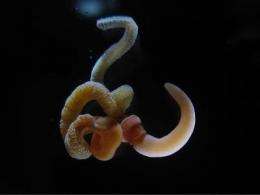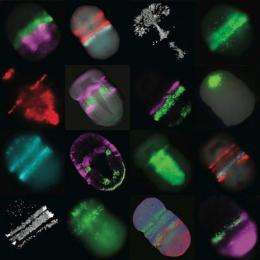In a brainless marine worm, researchers find the developmental 'scaffold' for the vertebrate brain

The origin of the exquisitely complex vertebrate brain is somewhat mysterious. "In terms of evolution, it basically pops up out of nowhere. You don't see anything anatomically like it in other animals," says Ariel Pani, an investigator at the Marine Biological Laboratory (MBL) in Woods Hole and a graduate student at the University of Chicago.
But this week in the journal Nature, Pani and colleagues report finding some of the genetic processes that regulate vertebrate brain development in (of all places) the acorn worm, a brainless, burrowing marine invertebrate that they collected from Waquoit Bay in Falmouth, Mass.
The scientists were searching for ancestral evidence of three "signaling centers" in the vertebrate embryo that are major components of an "invisible scaffold that sets up the foundation of how the brain develops," Pani says. Diagnostic molecular features of these signaling centers are mostly missing in the sea squirts and the lancelets, the invertebrate chordates that are the closest evolutionary relatives of the vertebrates. This had suggested that these signaling centers are key innovations that arose de novo in the vertebrate lineage.
Yet, surprisingly, the scientists found highly similar signaling centers in the more distantly related acorn worm (Saccoglossus kowalevskii), a hemichordate. Acorn worm embryos lack nervous system structures comparable to vertebrate brains, and their lineages diverged from vertebrates more than 500 million years ago. Pani and colleagues found that, in the acorn worm, the signaling centers direct the formation of the embryonic body plan.

"What this means is the last (common) ancestor of the hemichordates and the vertebrates, even though it presumably did not have a vertebrate-like nervous system, had some very complex and vertebrate-like mechanisms for establishing its body plan," Pani says. "And one of the broad implications is that weird, squishy marine animals can be very informative in terms of understanding the evolution of vertebrate development and genetics in a way that you wouldn't expect."
But the sea squirt shouldn't worry: it has not been usurped by the acorn worm. "The lancelet and ascidians (sea squirts) will still be the first animals we will look at if we want to understand vertebrate evolution. But if we find differences, we now know it is important to look at anatomically divergent animals, where you wouldn't have previously expected to find compelling similarities," Pani says. "I think this principle applies broadly to understanding animal evolution."
The MBL, where more than 200 different types of marine animals are collected and maintained, has long been a center for comparative studies of evolution and development. "It is a valuable perspective that scientists can now implement in a pretty straightforward way," Pani says. "Because of the advances in gene sequencing and developmental techniques, a lot of researchers are now free to pick an animal in an interesting place (in the evolutionary tree) and pursue research on it at a speed that wasn't possible before. I think that is going to have a really big impact."
Christopher Lowe, Pani's Ph.D. advisor, has been working on hemichordates at MBL since 2002, in collaboration with the labs of John Gerhart, Marc Kirschner, Elena Casey, and Mark Terasaki. "The MBL has been a great place for us to work," Pani says. "There is a lot of expertise on the rearing and spawning of the animals, and we have had a ton of help from staff. Zeiss and Nikon have loaned us equipment at the MBL for years. It's just been a really unique and collaborative environment combining organismal knowledge with high-end technical facilities."
Provided by Marine Biological Laboratory











.jpg)





